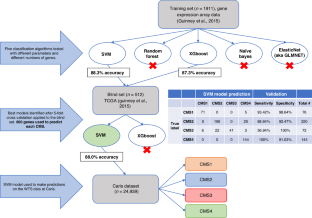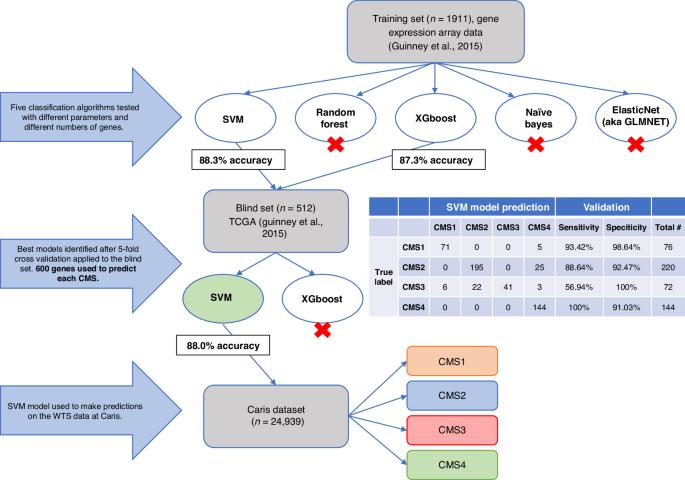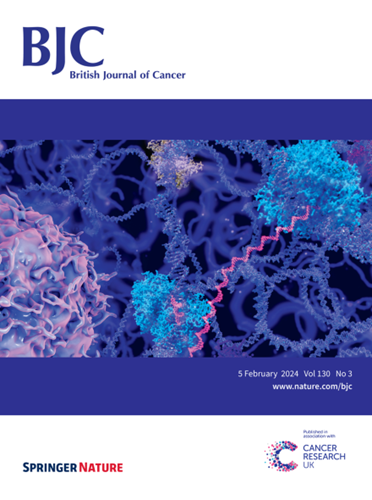转移性结直肠癌的分子亚型共识扩大了 CMS1 和 CMS2 肿瘤患者的生物标志物导向治疗效益。
IF 6.4
1区 医学
Q1 ONCOLOGY
引用次数: 0
摘要
背景:我们利用FFPE组织开发了基于全转录组测序(WTS)的共识分子亚型(CMS)分类器,并在大型CRC患者临床基因组数据库(n = 24,939)中研究了其预后和预测作用:使用 SVM 模型针对原始 CMS 数据集训练分类器,并在独立盲法 TCGA 数据集中进行验证(准确率为 88.0%)。计算了每个CMS的总生存期(OS)和治疗时间(TOT)的Kaplan-Meier估计值(P 结果:CMS2肿瘤位于结肠左侧,中位生存期最长。在RAS-野生型mCRC中,左侧肿瘤和CMS2分类与抗EGFR抗体(西妥昔单抗和帕尼单抗)的TOT时间较长有关。如果仅限于CMS2,右侧和左侧肿瘤的TOT没有明显差异。与其他CMS组相比,CMS1肿瘤使用pembrolizumab的中位TOT时间更长,即使只分析微卫星稳定(MSS)肿瘤也是如此:基于WTS的CMS分类器可对大型多机构临床基因组学mCRC队列进行研究,表明抗EGFR治疗可使右侧RAS-WT CMS2肿瘤获益,免疫检查点抑制剂可使MSS CMS1肿瘤获益。CRC的常规CMS分类提供了重要的治疗关联,应进一步加以研究。本文章由计算机程序翻译,如有差异,请以英文原文为准。


Consensus molecular subtyping of metastatic colorectal cancer expands biomarker-directed therapeutic benefit for patients with CMS1 and CMS2 tumors
We developed a whole transcriptome sequencing (WTS)-based Consensus Molecular Subtypes (CMS) classifier using FFPE tissue and investigated its prognostic and predictive utility in a large clinico-genomic database of CRC patients (n = 24,939). The classifier was trained against the original CMS datasets using an SVM model and validated in an independent blinded TCGA dataset (88.0% accuracy). Kaplan–Meier estimates of overall survival (OS) and time-on-treatment (TOT) were calculated for each CMS (p < 0.05 considered significant). CMS2 tumors were enriched on left-side of colon and conferred the longest median OS. In RAS-wildtype mCRC, left-sided tumors and CMS2 classification were associated with longer TOT with anti-EGFR antibodies (cetuximab and panitumumab). When restricting to only CMS2, there was no significant difference in TOT between right- versus left-sided tumors. CMS1 tumors were associated with a longer median TOT with pembrolizumab relative to other CMS groups, even when analyzing only microsatellite stable (MSS) tumors. A WTS-based CMS classifier allowed investigation of a large multi-institutional clinico-genomic mCRC cohort, suggesting anti-EGFR therapy benefit for right-sided RAS-WT CMS2 tumors and immune checkpoint inhibitor benefit for MSS CMS1. Routine CMS classification of CRC provides important treatment associations that should be further investigated.
求助全文
通过发布文献求助,成功后即可免费获取论文全文。
去求助
来源期刊

British Journal of Cancer
医学-肿瘤学
CiteScore
15.10
自引率
1.10%
发文量
383
审稿时长
6 months
期刊介绍:
The British Journal of Cancer is one of the most-cited general cancer journals, publishing significant advances in translational and clinical cancer research.It also publishes high-quality reviews and thought-provoking comment on all aspects of cancer prevention,diagnosis and treatment.
 求助内容:
求助内容: 应助结果提醒方式:
应助结果提醒方式:


